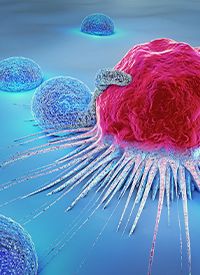ABSK061 Demonstrates Safety, Preliminary Efficacy in FGFR2/3+ Advanced Solid Tumors
ABSK061 was well tolerated and elicited responses in patients with advanced solid tumors harboring FGFR2/3 alterations.
stock.adobe.com

Treatment with the selective FGFR2/3 inhibitor ABSK061 was well tolerated and elicited responses among patients with advanced solid tumors harboring FGFR2/3 alterations, according to data from a first-in-human phase 1 trial (NCT05244551) presented at the 2024 ESMO Targeted Anticancer Therapies Congress.1
Findings showed that patients evaluable for efficacy (n = 8) experienced an overall response rate (ORR) of 37.5%, which was comprised entirely of partial responses (PRs). The disease control rate (DCR) was 75%. Among 3 of the patients to achieve a PR, 1 patient had non–small cell lung cancer (NSCLC) and received 4 prior lines of therapy; another patient presented with urothelial carcinoma and had received 2 prior lines of therapy; and the third patient had gastric cancer with 2 prior lines of therapy.
In the safety population (n = 29), no dose-limiting toxicities (DLTs) were reported during dose escalation. Treatment-related adverse effects (TRAEs) were generally low grade and reversible, and no patients discontinued treatment due to TRAEs. The most common any-grade TRAEs were increased aspartate aminotransferase (AST) and increased alanine aminotransferase (ALT), which each occurred in 31% of patients.
Regarding AST/ALT elevation, lead study author Ji Zhu, MD, noted that nearly half of patients in the safety population had liver metastases.
“Dose-escalation data validate ABSK061 as the first highly selective FGFR2/3 inhibitor that targets driver alterations,” Zhu said in a presentation of the data. Zhu is a member of the Department of Radiotherapy Oncology at Zhejiang Cancer Hospital in Hangzhou, China.
Preclinical models demonstrated that ABSK061 exhibited higher selectivity for FGFR2/3 compared with FGFR1, informing the hypothesis that this selectivity could lead to decreased toxicities and improved efficacy in clinical trials.
The open-label, phase 1 study enrolled patients with solid tumors who progressed on, were intolerant to, or declined standard-of-care therapy.1,2 Patients were required to have an ECOG performance status of 0 or 1; a life expectancy of at least 3 months; and adequate organ and bone marrow function.2
During dose escalation, patients received ABSK061 at 5 mg twice per day (n = 1), 10 mg twice per day (n = 1), 20 mg twice per day (n = 1), 35 mg twice per day (n = 3), 50 mg twice per day (n = 3), 75 mg twice per day (n = 7), 100 mg twice per day (n = 3), or 150 mg once per day (n = 4). Two cohorts also examined recommended doses for expansion (RDEs) at 150 mg once per day (n = 3) and 75 mg twice per day (n = 3). Enrollment is ongoing in the RDE cohorts, where patients are required to have activating FGFR2/3 alterations.1
Incidence of DLTs and AEs served as the primary end points of the study. Secondary end points included ORR, duration of response, DCR, progression-free survival, and pharmacokinetics.2
In the safety population, the median age was 54.0 years (range, 46.0-63.0), and 44.8% of patients were female. The majority of patients were Asian (96.6%) and had an ECOG performance status of 1 (93.1%). Prior lines of systemic therapy included 0 (3.4%), 1 (24.1%), 2 (37.9%), and 3 or more (34.5%). Notably, 93.1% of patients received prior chemotherapy, and 58.6% were previously treated with immunotherapy.1
Tumor types included bladder cancer (3.4%), cervical cancer (13.8%), cholangiocarcinoma (10.3%), colorectal cancer (10.3%), esophageal cancer (3.4%), gastric cancer (17.2%), gastroesophageal cancer (3.4%), NSCLC (10.3%), pancreatic cancer (6.9%), sarcoma (10.3%), small cell lung cancer (3.4%), and other (6.9%).
Additional safety data showed that other common any-grade TRAEs reported in at least 15% of the safety population included retinal pigment epithelial dystrophy/central serous retinopathy (RPED/CSR; 20.7%), increased alkaline phosphatase (17.2%), anemia (17.2%), hyperphosphatemia (17.2%), and diarrhea (17.2%). Grade 3 or higher increased AST and increased ALT each occurred in 3.4% of patients. Notably, all instances of RPED/CSR and hyperphosphatemia were grade 1 and reversible.
The rates of stomatitis, dry mouth, nail toxicity, alopecia, and palmar-plantar erythrodysesthesia were 10.3%, 6.9%, 3.4%, 3.4%, and 3.4%, respectively. No treatment-related dry eye was reported.
References
- Zhu J, Song Z, Zhao Y, et al. First-in-human study of ABSK061: A selective fibroblast growth factor receptor (FGFR) 2/3 inhibitor for treating patients with advanced solid tumors. Ann Oncol. 2024;9(suppl 1):1-11. doi:10.1016/esmoop/esmoop102271
- A study to assess safety, tolerability, and pharmacokinetics of ABSK061 in patients with advanced solid tumors. ClinicalTrials.gov. Updated November 16, 2023. Accessed March 6, 2024. https://clinicaltrials.gov/study/NCT05244551



